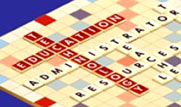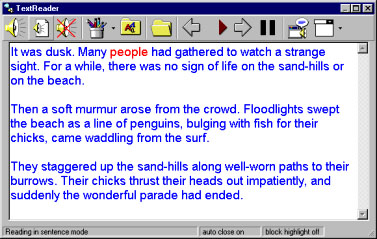
 |
| [ ASET ]
[ Proceedings Contents ] |
This paper discusses the findings of a recent study that investigated an aspect of the use of computer text reading software by secondary school students. Synthesised-speech reading of text by the computer allows users to access information aurally as well as reading it from the screen. Text reading programs may be valuable in an assistive role, independent of reading remediation activities, in that they may provide an alternative method of independent access to text at a higher level than would be possible without such assistance. A comparison was made of the reading comprehension of students using a text reading program, Read and Write (Texthelp, 2001), and their reading comprehension without assistance. The study found that the students were able to answer significantly more questions about what they had read, when using Read and Write than when reading unassisted.
Reading problems and the limitations these problems place on students' use of written texts may persist throughout schooling. "It is clear that on average the poor reading students do not catch up with their peers, nor do they grow out of their reading problem" (Greaves, 1999, p236). It is therefore important to investigate a range of possible strategies to assist students who have reading difficulties, including the use of assistive technologies that may allow them to circumvent some of their difficulties.
Hearing the text spoken by a computer is an alternative way to access information and may provide some students with more independent access to the content of reading materials. There may, therefore, be an opportunity to reduce the limitations that weaker reading skills place on these students' use of printed or electronic texts. Synthesised speech reading of text by the computer allows users to access information aurally as well as, or instead of, reading it on the screen or in a paper version. The terms 'Text-to-Speech' (TTS), 'speech synthesis', 'screen reader', and 'text reader' are all used to describe speech output of text. In this paper the term 'Text Reader' is used to refer generally to any software feature that can be used to hear selected text as speech, it is also the name of the text-speaking feature in some software. The use of this technology may be valuable to some students whose reading skills make it difficult for them to cope with the level of reading required for their studies.
A computer text reader allows text to be read from existing electronic documents or can be used in conjunction with other applications such as word processors or spreadsheets to give speech feedback on text entered by the user. The prevalence of electronic text has simplified the process of listening to text read by a computer, as the preliminary stage of scanning printed materials to convert the printed text into an electronic form is required less often. Students have access to a broad range of materials already in electronic form through their home or school computers. Students can use text-to-speech systems in conjunction with Internet resources such as web pages or e-mails, documents on a school intranet, electronic books, reference materials such as encyclopaedias on CD-ROM and an increasing number of textbooks. Some form of text reading with speech output is widely recommended as an option that should be considered for students with reading difficulties or disabilities (Raskind, 1998; Bryant & Bryant 1998; Rivera & Smith; 1997).
The process of selecting assistive technology for a student experiencing difficulties with academic tasks varies according to the requirements and practices of the people and organizations involved. Many researchers in this area suggest similar key elements in an effective assessment and selection process: a close examination of the needs and characteristics of the individual learners, the tasks the learner needs to perform, and any benefits the technology can provide for the learner undertaking these tasks (Raskind, 1998; Bryant & Bryant, 1998; Rivera & Smith, 1997).
Research into the use of speech output of text as a support for reading comprehension indicates that the effect is different for individual students (Montali & Lewandowski, 1996; Higgins & Raskind, 1997; Elkind, Cohen & Murray, 1993; Elkind, Black & Murray, 1996; Elkind, 1998). Some students experience an improved reading comprehension while for others there was no effect or a detrimental effect. The secondary and post secondary students in these US studies were previously identified as have a reading related learning disability. Elkind et al (1993) found significant gains in reading comprehension when using a text reader. Montali and Lewandowski (1996) found that the reading comprehension of the less skilled group using a text reader was similar to the unassisted performance of a control group of average readers. A negative correlation was found between benefit experienced and the students' unassisted reading performance (Elkind et al., 1996; Elkind, 1998, and Higgins and Raskind, 1997), meaning that "The greater the disability in reading comprehension, the more likely it was that the technology would assist students in compensating for their difficulties" (Higgins and Raskind, 1997, p80).
Examination of research in this field by (MacArthur, Ferretti, Okolo and Cavalier, 2001) concludes that: "It seems likely that the effects of screen reading depend on the characteristics of the students. Future research should focus on determining which students benefit from screen reading programs rather than looking for overall effects" (MacArthur et al., 2001, p297).
The use of a computer text reader as a support for reading comprehension was investigated with a group of 34 Year 9 students from a government secondary college in an outer Melbourne suburb. All students from two classes were invited to participate and there was no selection based on ability or academic performance. The 34 participants (18 males and 16 females) had a mean age of 14 years and 7 months.
The study investigated the effect of a text reader on reading comprehension, and the relationship between this effect and characteristics of the students' reading abilities. The general reading skills of the students were assessed using an established testing instrument, the Neale Analysis of Reading Ability (Neale, 1999). These students undertook short reading-based tasks to allow a comparison of reading comprehension with and without the use of the Text Reader feature of the computer software Read and Write, 5.0 (textHELP, 2001). The features of Read and Write can be used in conjunction with any Windows-based application (textHELP, 2001). Read and Write can provide synthesised speech reading of text and screen information as well as vocabulary and writing support. Only the Text Reader feature of Read and Write was used during this study. An additional window (Figure 1) opened when the Text Reader was activated, displaying the selected text as it was 'spoken' by the computer.

Figure 1: Text from the Neale Analysis of Reading Ability,
displayed in the Text Reader window of Read and Write.
The first stage of the study measured the reading abilities of students and provided scores for each student in Reading Accuracy, Reading Comprehension, and Reading Rate. The Neale Analysis of Reading Ability (1999) does not provide standardised scores for students in the age group of these subjects, but the test scores allowed comparison of relative performances and provided some indication of which students are experiencing difficulties in any of these three components of reading ability.
The second stage of the study used two other parallel forms of the Neale Analysis (Diagnostic Tutor Form A and Form B) as source material for using the text reader with some silent reading tasks. The students were required to read a series of graded pairs of short texts and answer questions about what they had read, as a measure of their reading comprehension. All texts were displayed on the screen of a notebook computer. The text reader feature of Read and Write 5.0 (textHELP, 2001) was used for alternate texts so that each student read half of the texts with additional speech output from the text reader, and the other half without assistance. As a further control half the students read from Form A of the Neale Analysis with the text reader and from Form B without assistance, the conditions were reversed in the other group. The terms 'without assistance' and 'unassisted' as used in this study refer to the condition in which the student is not using the text reader, and do not imply that using a text reader assists the student.
The effect of using a text reader as a support for reading comprehension was varied. Although there was an overall increase in reading comprehension when using the text reader, the experiences of individuals ranged from improved to diminished performances on the reading tasks. It is perhaps more interesting to consider the relationship between unassisted reading performance and gains in reading comprehension when using the text reader. The findings of this study are consistent with the studies of Montali and Lewandowski (1996), Raskind and Higgins (1997), Elkind et al. (1993), and Elkind (1998) who found that the use of a text reader tended to elevate the reading comprehension of the less proficient readers and depress the performance of the more proficient readers.
Elkind, J., Cohen, K. & Murray, C. (1993). Using computer-based readers to improve reading comprehension of students with dyslexia. Annals of Dyslexia, 43, 238-259.
Elkind, J., Black, M.S. & Murray, C. (1996). Computer-based compensation of adult reading disabilities. Annals of Dyslexia, 46, 159-186.
Elkind, J. (1998). Computer reading machines for poor readers. Perspectives, 24(2), 9-14.
Greaves, D. (1999). The role of phonological awareness in second wave teaching. In D. Barwood, D. Greaves & P. Jeffery (Eds), Teaching Numeracy and Literacy: Interventions and Strategies for "At Risk" Students (pp235-251). Melbourne: Australian Resource Educators' Association.
Higgins, E.L. & Raskind, M.H. (1997). The compensatory effectiveness of optical character recognition/speech synthesis on reading comprehension of postsecondary students with learning disabilities. Learning Disabilities: A Multi-disciplinary Journal, 8(2), 75-87.
MacArthur, C.A., Ferretti, R.P., Okolo, C.M. & Cavalier, A.R. (2001). Technology applications for students with literacy problems: A critical review. Elementary School Journal, 101(3), 273-301.
Montali, J. & Lewandowski. L. (1996). Bimodal reading: Benefits of a talking computer for average and less skilled readers. Journal of Learning Disabilities, 29(3), 271-279.
Neale, M.D. (1999). Neale Analysis of Reading Ability (3rd ed.) Melbourne: Australian Council for Educational Research.
Raskind, M.H. (1998). Literacy for adults with learning disabilities through assistive technology. In S.A.Vogel & S. Reder (Eds), Bridging the Gap: Learning Disabilities, Literacy, and Adult Education. (pp253-268) Baltimore, MD: Brookes.
Rivera, D.P. & Smith, D.D. (1997). Teaching Students with Learning and Behaviour Problems. (3rd ed.) Boston: Allyn and Bacon.
textHELP (2001). Read and Write (Version 5.0) [Computer Software], Antrim: textHELP Systems.
| Please cite as: Disseldorp, B. and Chambers, D. (2002). Independent access: Which students might benefit from a talking computer? In S. McNamara and E. Stacey (Eds), Untangling the Web: Establishing Learning Links. Proceedings ASET Conference 2002. Melbourne, 7-10 July. http://www.aset.org.au/confs/2002/disseldorp.html |